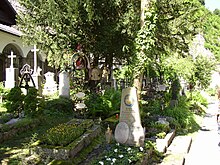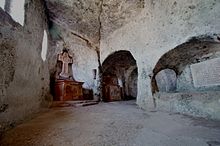Petersfriedhof Salzburg
The Petersfriedhof (cemetery of the St. Peter monastery ) is the oldest Christian burial place in Salzburg , along with the cemetery of the Nonnberg monastery .
Due to its location at the foot of the rock of the fortress mountain and its picturesque surroundings, which always open up new perspectives, the Petersfriedhof was a preferred subject of painting and poetry of the 19th century.
“O beautiful place, chosen
for the dead As a resting place for the tired limbs!
Here spring sings songs of resurrection,
conjured back by the faithful gaze of the sun.
When all pains pierce a heart, to
whom one lowers one's loved one to the pit,
But it is easier to believe here: we
will meet again, the dead are not entirely lost to us.
The strange wanderer, coming from afar, for
whom no luck has rotted away here, likes to stay
here, where beauty is the guardian of the dead.
They sleep deeply and gently in their arms,
Wherein warm them to new life;
The flowers beckon, their silent messengers. "
history
The St. Peter cemetery is most likely the same age as the St. Peter monastery itself, i.e. it dates back to around the year 700. But there was already a cemetery in this room during the time of the Great Migration. At first the cemetery was only intended for members of the monastery. The first documentary evidence is the granting of the burial right by Archbishop Konrad I. von Abensberg on March 22nd, 1139. The cemetery was probably smaller then than it is today or it had a different shape, since in the space between the Kreuzkapelle and the collegiate church the St. Peter stood. The oldest surviving tombstone in this cemetery is that of Abbot Dietmar († 1288). The tombstone bears the inscription † VI. K. Martii. Obiit. I Dietmar. Abas. S. Pet. A tombstone with the oldest family coat of arms and the inscription Hie leit her Man Gaerr ... dates from the year 1300 (both tombstones today in the cloister of the monastery). Many deceased from well-known families of the Middle Ages are buried here, such as 1327 Heinrich von Prunning, 1343 Wulfingus and 1358 Wulfingus Junior von Goldek (from the family of the Lords of Goldeck), 1360 Ann de Nussdorferin from the family of the Lords of Nussdorf . The family grave of the Lords of Keuczl (Keutzl, since 1589), that of the Lords of Lasser (after 1530), a Warbar von Keutschach in 1538 and the grave of Werner von Raittenau zu Langenstein (1593), the father of Archbishop Wolf, are from a later period Dietrich von Raitenau is remarkable. A medieval burial tomb for monks was discovered in St. Peter's Cemetery in 1865, but walled up again in the same year. Under Abbot Petrus (1436–1466) the cemetery was surrounded by a cemetery wall. The first cemetery regulations come from Abbot Beda Seeauer (1753–1785).
With the announcement of December 9, 1878, the cemetery was closed for funerals, since the Salzburg municipal cemetery was then considered to be the city's only cemetery in future. At that time, however, no one was aware of the consequences of the abandonment of the cemetery for the cityscape. Major signs of deterioration began to appear around 1900. At that time, it was also discussed to partially dissolve the cemetery and use the ground for the passenger funicular to the fortress mountain. The plan subsequently failed due to persistent resistance from the monastery as the landowner. Until 1930, the monastery and some crypt owners ensured the preservation of the cemetery on its own account. The city's magistrate recognized this effort by allowing new burials in this cemetery as of March 24, 1930.
The "catacombs" (hermitage, hermitage)
At the edge of St. Peter's Cemetery are the so-called " catacombs ", which were carved into the fortress mountain. They are probably of late antique-early Christian origin and, despite their name, were not used as burial sites, but rather as early Christian meeting places. They were later associated with the legend of the priest Maximus, who was martyred in AD 477. The local information in this legend does not refer to Salzburg, nor is the figure of Saint Maximus historically documented.
The commune call
The catacombs are accessible west of the crypt arcades through the commune crypt , from which a staircase leads up to the two chapels that were once carved out of the mountain as cave structures, but later became partially visible through rockfalls and were then bricked up again. The commune crypt is also home to the only graves next to the catacombs: at the beginning of the 19th century, for example, Mozart's sister Nannerl and the composer Michael Haydn, who was a friend of her, were buried in the crypt.
The crypt arcades


The crypts IV-VII were built around 1625, the crypts IX-XXIV 1615–1626 and the crypts XXV-LIV 1626–1630. Most of these arcades were designed by master bricklayer Christoph Gottsreiter . The epitaphs and wrought iron grille come from the time between the 17th and 20th centuries.
In the crypt arcades are buried :
- Gregor Baldi (1814–1878, crypt no.34)
- Maria Anna von Berchtold zu Sonnenburg (1751–1829, crypt no. 54), Mozart's sister
- Mathias Gschnitzer (1808–1884, crypt no. 28), Mayor of the City of Salzburg
- Johann Georg Hagenauer (1748–1835, crypt no. 52)
- Johann Lorenz Hagenauer (crypt No. 16)
- Wolfgang Hagenauer (1726–1801, crypt no. 52)
- Sigmund Haffner the Elder Ä. , (1699–1772, crypt no. 39), mayor of the city of Salzburg
- Sigmund Haffner the Elder J. (1756–1787, crypt no.39)
- Michael Haydn (1737–1806, crypt no.54)
- Ferdinand Holböck (1913–2002, crypt no.31)
- Gustav Kapsreiter (1893–1971, crypt no.33)
- Robert Keldorfer (1901–1980, crypt no. 32)
- Herbert Klein (1900–1972, crypt no. 51)
- Carl Mayr (1875–1942, crypt no.33)
- Richard Mayr (1877–1935, crypt no.33)
- Heinrich Ritter von Mertens (1811–1872, crypt no. 19), mayor of the city of Salzburg
- Franz Heinrich von Naumann (1749–1795, crypt no. 32)
- Johann Christian Paurnfeind (1687–1768, crypt no. 50), Mayor of the City of Salzburg
- Otto Pflanzl (1865–1943, crypt no. 41), local poet
- Santino Solari (1576–1646, crypt no. 31), builder of the Salzburg Cathedral
- Josef Thorak (1889–1952, crypt No. 25), sculptor
- Franz Wasner (1905–1992, crypt no. 51)
- Ignatz Anton von Weiser (1701–1785, crypt no. 22), mayor of the city of Salzburg, wrote the libretto for " The debt of the first commandment "
The burial ground

The burial place of the famous court stone mason and master mason Sebastian Stumpfegger with seven crosses is located in the grave field . The irreverent and untrue allegation that tourist guides used to like to entertain their guests, according to which this prominent and highly talented employee Johann Bernhard Fischer von Erlachs had maliciously murdered his supposedly six wives, should be erased from memory. In reality, the inscriptions on the seven crosses are reminiscent of Master Sebastian Stumpfegger, his four wives and his parents.
Also noteworthy is the humorous saying on a grave stone of a member of the Salzburg Museum Carolino Augusteum in 1870: Lived happily, no joke spoiled, - Much troubled and nothing acquired, - Many friends, little money - Was his lot in this world .
Famous personalities in the row graves
- Josef Becvar , architect
- Harry J. Collins , commander of the 42nd Rainbow Infantry Division
- Anton Dawidowicz , composer and cathedral music director of Salzburg
- Joseph Eberle , writer
- Martin Hell , engineer and prehistoric
- Richard Hildmann , Mayor of the City of Salzburg
- Ernst Hinreiner , conductor
- Clemens Holzmeister , architect
- Armin Kircher
- Josef Klampfer , well-known Salzburg crib artist 1892–1962
- Matthias Kracher (1752–1835) (monastery organist in Seekirchen, composer, teacher in Kuchl)
- Matthias Laireiter , State School Inspector, Amtsf. President of the state school board
- Hans Lechner , Governor of Salzburg
- Franz Martin , art historian
- Andreas Nesselthaler (the last Salzburg court painter)
- Bernhard Paumgartner
- Georg Pezolt
- Heinz Politzer
- Ferdinand Prillinger , Director of the Salzburg Federal Teachers ' Training Institute and the Pedagogical Institute
- Otto Prossinger (1906–1987), architect
- Alois Schmiedbauer
- Georg Schuchter , actor
- Josef Engelbert Tomaschek , parish priest of Salzburg-Herrnau (* February 18, 1913; † November 30, 1996)
- Wilhelm Wolf , politician
Further cemeteries in the city of Salzburg
- Salzburg municipal cemetery
- Sebastian Cemetery
- Jewish cemetery Salzburg
- Maxglan Cemetery
- Aigen cemetery
- Gnigl cemetery
- Leopoldskron cemetery
- Morzg cemetery
- Liefering cemetery
- Mülln cemetery
- Nonnberg Monastery cemetery
- Military cemetery in the Nonntaler Donnenbergpark
See also
literature
- Conrad Dorn, Andreas Lindenthaler: The St. Peter cemetery in Salzburg . Verlag St.-Peter, 1982, Salzburg, ISBN 3-900173-37-0 .
- Wolfgang Steinitz: Salzburg an art and travel guide for the city and its surroundings , Residenz Verlag, Salzburg 1984, ISBN 3-7017-0003-6 .
- Adolf Haslinger , Peter Mittermayr (eds.): Salzburger Kulturlexikon , Residenz Verlag, Salzburg 1987, ISBN 3-7017-0503-8 .
Web links
Individual evidence
Coordinates: 47 ° 47 '48 " N , 13 ° 2' 44" E





